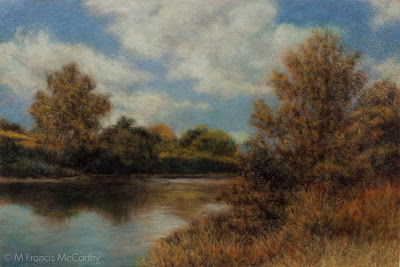My visit to the de Young Museum left me with two things. A big interest in pre impressionist American landscape painting, like the
Hudson river school, the
Luminists and most importantly
Tonalism. And, I also learned to pay special attention to a paintings surface quality. I wanted my paintings to to have some of that classic feeling that I saw in the paintings of past landscape masters and I knew surface quality was a big part of the equation.
I abandoned canvas in favor of painting directly on wood panel. Liquin also factored in my new approach to surface quality as it allowed me to quickly layer colors while building a nice surface with paint, Liquin, the wood grain and my layers of clear gesso over the bare wood.
 |
| Late Summer (6x9) Pond by M Francis McCarthy |
Surface quality in a painting refers to the texture and reflective quality of the paintings finish. This aspect of a painting becomes most apparent when viewing the original piece obliquely but also effects the viewers spacial reference to and appreciation of, the painting.
Many great old paintings, often done on wood or heavily gesso'ed canvas, exude an awesome character that seems to be missing from a lot of modern work.
One reason is because many of today's painters, paint directly on top a store bought canvas's natty acrylic white pre-prepped surface. I'm not dissing them but I am saying that you get back what you put out. A cheap start will lead to a cheap finish, or it can.
I feel that every stage of the painting should be done with love and care. Starting from using a properly prepared board or canvas. Here above are the Kauri Boards that I'm using for my current series. They are 100% lovely Kauri Marine plywood:
Marine plywood is manufactured from durable face and core veneers, with few defects so it performs longer in humid and wet conditions and resists delaminating and fungal attack. Its construction is such that it can be used in environments where it is exposed to moisture for long periods. Each wood veneer will be from durable tropical hardwoods, have negligible core gap, limiting the chance of trapping water in the plywood and hence providing a solid and stable glue bond. It uses an exterior Water and Boil Proof (WBP) glue similar to most exterior plywoods.
Marine plywood is frequently used in the construction of docks and boats. It is much more expensive than standard plywood: the cost for a typical 4-foot by 8-foot 1/2-inch thick board is roughly $75 to $100 U.S. or around $2.5 per square foot, which is about three times as expensive as standard plywood.
I prep my boards with two to three coats of sanding sealer and sand them in between. As stated, marine ply costs three times more than the cheap stuff but you can feel the quality when your painting on it vs pine or another cheaper product.
BTW pine can be nice for smaller paintings. I prefer when painting small to use a textured surface anyway. I create the texture for my 5x5's and 5x7's using clear acrylic gesso, paper and the side of a brush to create a nice uniform yet varied surface texture that will grab paint off of my brush.
For my more finished paintings I like to utilize the wood texture inherent in my substrate and also create more texture with my brush strokes. I work quiet thin so sometimes the paintings surface is only perturbed slightly form the flat wood grain.
A trail is left by the all work that went into the painting and the paintings surface tells that tale. Eloquently I hope, if not ant least the attempt was made and attention was paid.






































